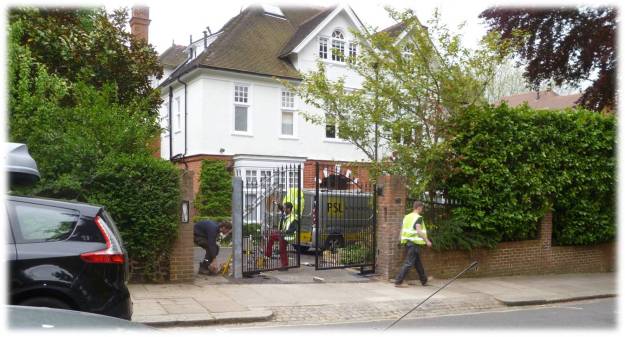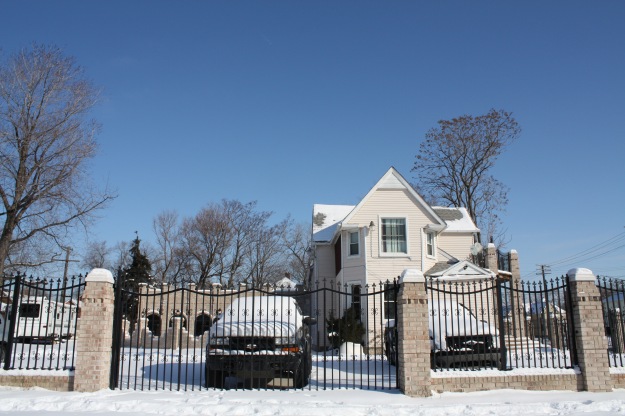Can we speculate that there is a relationship between the massive changes in policy and political life since the financial crisis of more or less ten years ago and the look and feel of the streets and homes and in our towns and cities? It was not long after the crisis began that I made a journey by car through the semi-rural areas bordering Manchester and Chester and was surprised at the number of homes with new, large and electronic gates. Why would we find these kinds of features in leafy areas with presumably low crime rates? Why indeed would we expect to find now well over a thousand gated communities in a country like the UK that has traditionally not only enjoyed a relatively low crime rate but also a history of more or less open streetscapes and a celebration of public footpaths and byways? We know that the reasons for these changes are complex and lie in a mix of factors that include a search for badges of social standing as well as a fear of crime. Yet the reality in many streets today is of a proliferation not of large gated communities but the rise of what Sarah Blandy and I recently called domestic fortresses LINK. In many neighbourhoods it is possible to see shuttered and gated large homes side-by-side with those with little or no such visible protection. What explains these variations and what does it mean, if anything at all, for questions of policy today?

Forting-up, London
One step-change in urban life appears to be a move from segregation at a neighbourhood level to sharper differences within local spaces. Much of these changes speaks also of changing community and social relations and the connections of social networks across space rather than the traditional pattern of, more often, knowing one’s neighbours and those in a geographical and proximate community. Life is different today along a series of rapid changes in many areas of daily life. It seems to have taken very little time for the assurances, and perhaps irritations, of community life and a sense of nation and state to be replaced by a deeper series of anxieties and losses within which the individual is both the celebrated author of their own social trajectory or fate. Sociologists have been banging-on about the loss of community and notions of risk for more than two decades but I was reminded of how far we had come while settling down to the gem of a book by Wolfgang Streek LINK who asks in his most recent book – When will capitalism end? For Streek the end will come not because of alternative plans and competing blueprints of a more equitable social and economic system, rather it is the massive contradictions of a system of based around the patronage of corporate life by governments, our wholesale surrender to markets at a global scale and the loss of x, to say nothing of climate change and the ecological limits of our condition, that present a kind of systemic over-reach that is much more likely to topple the principles by which we live rather than a unionized or revolutionary movement driven by mass social movements.

Fortress USA, Detroit
How is all of this relevant to gated communities and fortress homes I hear you ask in some exasperation? We know that things aren’t good and look set to be pretty unsettled in a fragmenting Europe and an uncertain global context with contests and displays of power between charismatic oligarchs and politicians so where does the home come into this? Well, the home links into this enormously complex and unsettled environment in one very important sense at least. Home is where we live. It is the place that we look out at all of this disruption and the site to which we project an array of dreams and desires about who we will become and the households and families around us. It, or a variant of it, is where we formed out ideas about how social life works and who we can distrust or should not at any costs. And for this environment to fully sustain and settle us requires not only the safety of the home but a sense of assuredness about the world outside.

Fortress, Australia
Much of the subjective life we inhabit, in our minds, also takes place inside the shell of the home and both, it seems, are under threat from myriad sources. Our lives are rules by short-term contracts, profit and enterprise orientations, selling our ‘selves’ through selfies and narcissistic displays, worried about crime or the threat of invasion (either in terms of the home or at the wider borders of the nation) and overseeing this is a diminished state that only seeks to usher or loosely regulate capital and companies. In such a fractured state who will we call if we have an emergency? If it is a public or private fire, police or ambulance service is increasingly open to new possibilities of contracting, sub-contracting, leases and other arrangements. Will the ambulance get to me in time to help if they cant navigate the gates? Who will help mitigate the risks generated by inequality and which include violent and other forms of criminal and harmful acts? Who will police those risks and help me if things go wrong? Of course all of these rhetorical questions point to the need for the role of a state with some capacity, capacities which are either voluntarily ceded by the central state or which are denuded by austerity [linkl to Crewe LRB piece] at the local level.
The fortress home is an expression of social escape from communities that no longer exist into a world of possibilities fed by an array of debt-financed consumer products, electricals, ICT and audio-visual systems. It is here that we are on our own but also triumphally placed by consumer advertising as the authors of our own emancipatory dreams and ambitions. We are also free to feel a gnawing sense of doubt, loneliness and anxiety rendered starkly in films like Cosmopolis or grotesquely but somehow presciently in depictions like Day of the Dead [check]. For the ultimate treatment of this condition we can more readily turn to the social science fiction of La Zona in which marginal social groups, desperate to make a living, invade a gated community to be viciously dealt with by an angry and fearful mob of armed homeowners in an unnamed, yet familiar, Latin American city. All of which points us to where I am going with all of this dystopian stuff – somewhere rather unpleasant, a place in which the hollowing of the state, social services, corporate excess and free license and gross wealth inequalities leaves us in fact disempowered yet dreaming of the possibility of escape from the Hobbesian conditions generated by the ideological tropes that we bought into, or were contracted-out on.

Jung’s home, a castellated dream
As with many things the tell-tale advance of what we can think of as a process of micro-fortification around, if not armed in this country, homeowners says something of our consumption-led identities, the escape to the freedome of some brave and unbounded social self that is connected to a disintegrating public realm. We might then suggest that political commitments to market logics lead us not only to the sense of an increasingly unequal and insecure society but also one that is more visibly differentiated between those that have and do not have security. The deeper lie undergirding this is that panic rooms, gated communities can offer-up a widely experienced sense of human security. And yet fearful subjects are also compliant to notions of hard-work for financial reward since who wants to be cast into the kinds of material and social insecurity that are so pervasive today? Yet the security fixes that we see around us are also illusory because they belie the deeper fact of the ineffectiveness which is to say that for security to really work we would also hope to feel more secure and on this dimension research tells us it is clearly failing.

So-called ‘Ha Ha’, Castle Howard, the illusion of an accessible rural idyll with earthworks inspired by war-time defensive systems.
All of this points the way for the need for an interest in social policy to connect closely to the politics of economic management and statecraft in which markets and international enterprise are heralded as all-powerful and universally benefitting. A concern with security, segregation, homeownership and gated communities combine in fact with a curiosity about who we as a society, and others like us, are becoming in a world that is cast by those in charge as being runaway and in need of riding, rather than taming. Streeck’s analysis appears enormously astute because it highlights the need for us to think and speak in different registers in ways that grasp the enormous and unsettling realities of global and national systems that give way to unchecked inequality and the subsequent impact of this insecurity on human life. To understand the rise of the domestic fortress we need to comprehend, like the best of sociologists, the multi-dimensional and reinforcing logics of a system that may yet kill itself but which, in the meantime, is likely to continue to do much damage yet.
This is a slightly extended version of my blog for the Policy and Politics journal blog.


